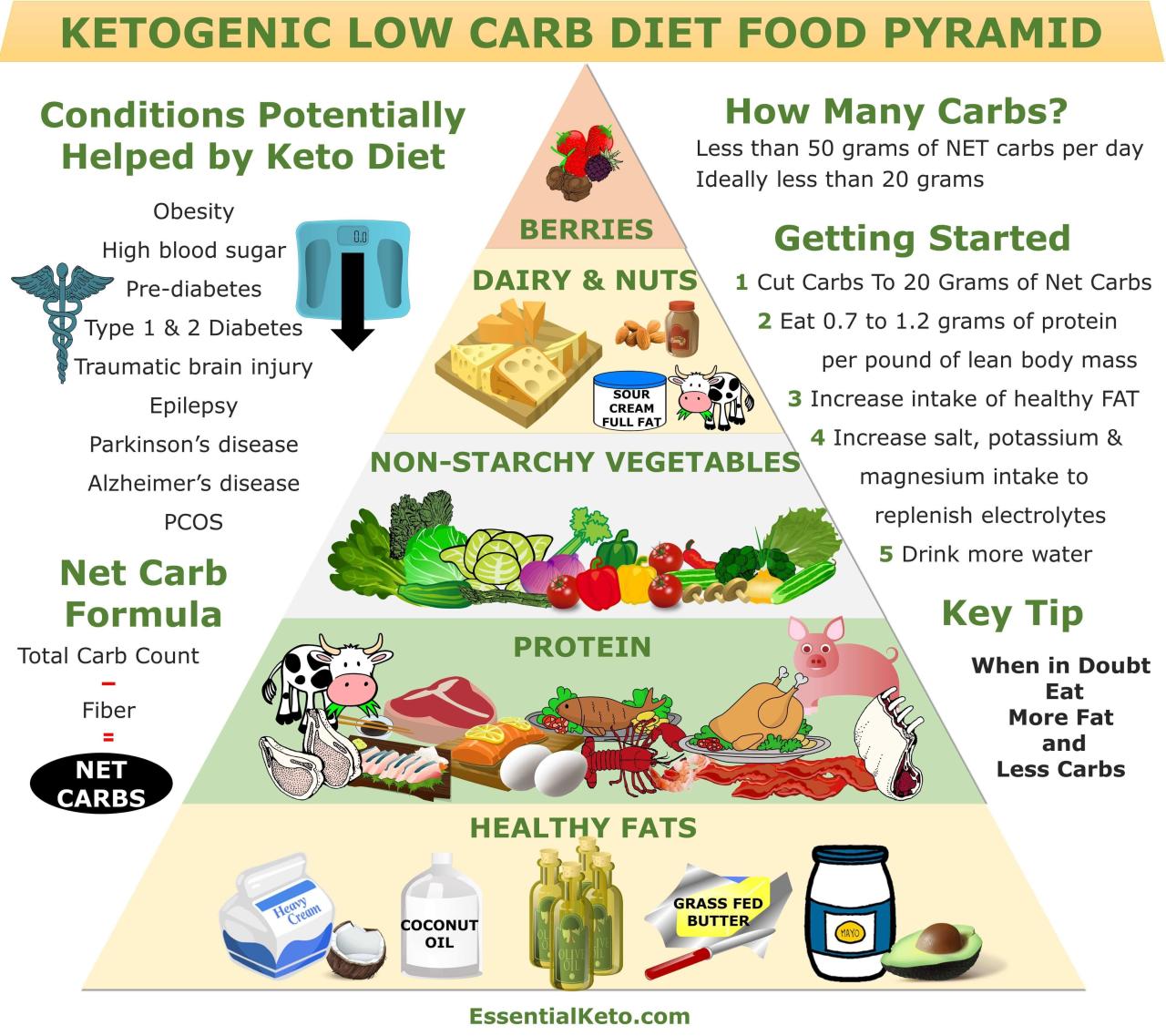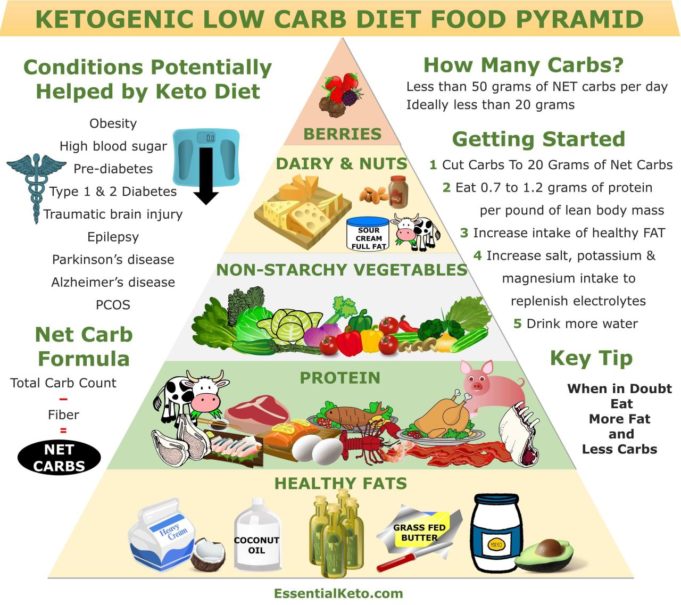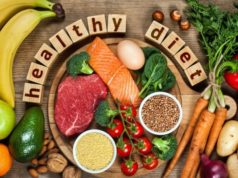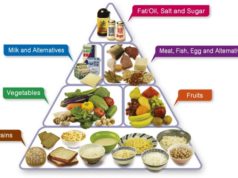How to do the keto diet? It’s a question on many minds these days, as the ketogenic diet, with its focus on fat and its restriction of carbs, has become a popular approach to weight loss, improved health, and even enhanced cognitive function.
But what exactly is this “fat-fueled” lifestyle, and is it truly the answer to your health and wellness goals?
The keto diet, in essence, forces your body to enter a state of ketosis, where it begins burning fat for energy instead of carbohydrates. This shift in metabolism can lead to various potential benefits, from shedding pounds to potentially improving blood sugar control.
However, as with any drastic dietary change, there are potential challenges to be aware of, such as nutrient deficiencies, the infamous “keto flu,” and the need for careful planning to ensure long-term sustainability.
What is the Keto Diet?
The ketogenic diet, often referred to as the keto diet, is a high-fat, low-carbohydrate eating plan that has gained immense popularity in recent years. It’s a diet that forces your body to enter a metabolic state called ketosis.
The Ketogenic Process
The ketogenic diet works by drastically reducing carbohydrate intake, forcing your body to turn to fat as its primary energy source. When you significantly limit carbs, your body starts breaking down fat into ketones, which then become the main fuel for your brain and other organs.
This metabolic shift is known as ketosis.
Macronutrient Breakdown
The keto diet typically emphasizes a macronutrient breakdown of:* High Fat:Approximately 70-80% of your daily calories should come from healthy fats.
Moderate Protein
The keto diet is all about ditching carbs and embracing fat, but even with all that butter, you might crave a little fizz. That’s where the age-old question comes in: Diet Coke or Coke Zero? It’s like choosing between a sassy chihuahua and a chill golden retriever.
Both are sugar-free, but the difference lies in the artificial sweeteners. To dive into the nitty-gritty, check out this breakdown of the difference between diet coke and coke zero. Whichever you choose, remember, moderation is key on the keto diet, even with zero-calorie beverages.
Aim for 15-20% of your daily calories from protein sources.
Low Carbohydrates
Carbohydrate intake is strictly limited to 5-10% of your daily calories.
Foods Included
The keto diet encourages the consumption of foods rich in healthy fats and protein, while limiting carbohydrates. Here are some examples:* Healthy Fats:Avocado, olive oil, coconut oil, nuts, seeds, fatty fish (salmon, tuna, mackerel)
Protein Sources
Meat, poultry, fish, eggs, cheese, Greek yogurt, tofu
Low-Carb Vegetables
Broccoli, cauliflower, spinach, kale, Brussels sprouts, asparagus
Foods Excluded
The keto diet strictly limits or eliminates foods high in carbohydrates:* Sugary Foods:Sugary drinks, candy, desserts, processed foods
Grains
Bread, pasta, rice, cereals
Starchy Vegetables
Potatoes, corn, peas
Fruits
Most fruits, especially those high in sugar like bananas, grapes, and oranges
Benefits of the Keto Diet

The ketogenic diet, or keto diet, has gained significant popularity in recent years, and for good reason! This high-fat, low-carbohydrate eating plan has been linked to a variety of health benefits, from weight loss to improved blood sugar control. But before you jump on the keto bandwagon, it’s crucial to understand the potential benefits and risks associated with this dietary approach.
Weight Loss
The keto diet is renowned for its effectiveness in promoting weight loss. By drastically reducing carbohydrate intake, the body enters a metabolic state called ketosis, where it begins to burn fat for energy instead of glucose. Numerous studies have shown that individuals following a ketogenic diet experience significant weight loss compared to those on traditional diets.
A 2019 study published in the journal
Obesity* found that individuals following a ketogenic diet for 12 weeks lost an average of 10.4 pounds more than those on a low-fat diet.
Improved Blood Sugar Control
The keto diet can be beneficial for individuals with type 2 diabetes. By reducing carbohydrate intake, the keto diet helps regulate blood sugar levels and may even reduce the need for medication.
A study published in the journal
Diabetes Care* found that individuals with type 2 diabetes who followed a ketogenic diet for 12 weeks experienced significant improvements in blood sugar control, including a decrease in HbA1c levels.
Reduced Inflammation
Chronic inflammation is linked to a range of health problems, including heart disease, cancer, and arthritis. The keto diet has been shown to reduce inflammation by promoting the production of ketones, which have anti-inflammatory properties.
A study published in the journal
Nutrients* found that individuals following a ketogenic diet for 6 weeks experienced a significant reduction in inflammatory markers in their blood.
Keto Diet Phases: How To Do The Keto Diet
The ketogenic diet is not a one-size-fits-all approach. It’s more like a journey with different phases, each with its unique set of rules and benefits. Understanding these phases is crucial for maximizing your keto experience and achieving your goals.
Induction Phase
This is the initial stage of the keto diet, typically lasting 2-4 weeks. During this phase, your primary focus is to achieve ketosis, the metabolic state where your body primarily burns fat for energy instead of carbohydrates. To enter ketosis, you need to drastically reduce your carbohydrate intake to a very low level, usually around 20-50 grams per day.
This forces your body to switch from using glucose (from carbs) to using ketones (from fat) as its primary fuel source. During this phase, you might experience some side effects, commonly known as the “keto flu.” These symptoms, which include fatigue, headaches, nausea, and constipation, are usually temporary and subside within a few days.
They are a sign that your body is adjusting to using fat as its primary fuel source. Here’s a sample meal plan for the induction phase:
- Breakfast:2 eggs with spinach and cheese, a cup of unsweetened coffee or tea
- Lunch:Salad with grilled chicken or fish, avocado, and a light vinaigrette dressing
- Dinner:Salmon with roasted broccoli and cauliflower
- Snacks:Keto-friendly nuts, seeds, or cheese
This phase is about establishing ketosis and experiencing the initial changes in your body.
The keto diet is all about ditching carbs and embracing fat, so you’ll be trading your pasta for avocados and your sugary drinks for, well, maybe a can diet coke if you’re feeling adventurous. But remember, even with diet soda, moderation is key, because you don’t want to be chugging artificial sweeteners all day long! The real magic of keto is in focusing on healthy fats and protein, so get those eggs and bacon ready!
Maintenance Phase, How to do the keto diet
Once you’ve successfully entered ketosis, you transition to the maintenance phase. This phase focuses on sustaining ketosis and maintaining a healthy weight. The carbohydrate intake is slightly higher than the induction phase, usually between 20-50 grams per day, but still low enough to keep your body in ketosis.
You’ll find that you have more energy and mental clarity during this phase, and your body will continue to adapt to using fat as its primary fuel source. This phase is about long-term sustainability, allowing you to enjoy a keto lifestyle without feeling deprived.
Here’s a sample meal plan for the maintenance phase:
- Breakfast:Keto-friendly smoothie with almond milk, protein powder, and berries
- Lunch:Leftovers from dinner, such as a keto chili or a stir-fry with tofu and vegetables
- Dinner:Steak with roasted asparagus and mushrooms
- Snacks:Full-fat yogurt with berries, or a handful of nuts
This phase is about maintaining ketosis and enjoying a balanced keto lifestyle.
Cyclical Ketogenic Diet
The cyclical ketogenic diet is a more advanced approach that involves cycling between periods of ketogenic eating and periods of higher carbohydrate intake. This is often used by athletes or those who want to maximize their performance or gain muscle mass.
This method involves spending several days in a strict ketogenic state, followed by a “carb-loading” day or two. The carb-loading days allow for increased glycogen stores in the muscles, which can enhance athletic performance. This phase is about optimizing your body for specific goals, like athletic performance, and requires careful planning and monitoring.
Here’s a sample meal plan for a cyclical ketogenic diet:
- Keto Days:Follow a strict keto diet with low carbs and high fat intake, as Artikeld in the maintenance phase.
- Carb-Loading Days:Include healthy carbohydrates like brown rice, quinoa, sweet potatoes, and fruits in your meals.
This phase is about strategically manipulating carbohydrate intake to achieve specific goals.
Keto Diet Recipes
The keto diet is all about delicious, satisfying meals that keep you in ketosis. Here’s a collection of keto-friendly recipes, categorized by meal type, to help you get started on your keto journey.
The keto diet is all about fat, fat, and more fat! It’s like a party in your mouth, and your body is the guest of honor. But if all that fat sounds a bit overwhelming, maybe you should check out some easy diets to follow that don’t require you to become a professional butter sculptor.
Of course, if you’re truly dedicated to the keto lifestyle, you’ll embrace the challenge and soon be whipping up avocado-based masterpieces in your kitchen.
Breakfast
Breakfast is the most important meal of the day, even on keto! These recipes will fuel your morning and keep you satisfied until lunch.
| Recipe Name | Ingredients | Instructions | Nutritional Information |
|---|---|---|---|
| Keto Avocado Toast |
|
|
|
| Keto Egg Muffins |
|
|
|
Lunch
Lunchtime on keto doesn’t have to be boring! These recipes are quick, easy, and packed with flavor.
| Recipe Name | Ingredients | Instructions | Nutritional Information |
|---|---|---|---|
| Keto Chicken Salad |
|
|
|
| Keto Tuna Salad |
|
|
|
Dinner
Dinner is the time to get creative with your keto cooking! These recipes are delicious and satisfying, perfect for a weeknight meal or a special occasion.
| Recipe Name | Ingredients | Instructions | Nutritional Information |
|---|---|---|---|
| Keto Salmon with Asparagus |
|
|
|
| Keto Chicken Stir-Fry |
|
|
|
Snacks
Snacks on keto are all about keeping you full and satisfied between meals. These recipes are easy to grab and go, and they’re packed with flavor.
| Recipe Name | Ingredients | Instructions | Nutritional Information |
|---|---|---|---|
| Keto Cheese Sticks |
|
|
|
| Keto Avocado Chocolate Mousse |
|
|
|
Keto Diet Challenges
The keto diet, while effective for weight loss and other health benefits, isn’t without its challenges. Like any major dietary change, it requires adjustment and can bring about some side effects. Let’s delve into some common challenges and how to overcome them.
Nutrient Deficiencies
The keto diet emphasizes fat intake and limits carbohydrates, which can lead to potential nutrient deficiencies. While the diet provides ample fat-soluble vitamins, it might fall short in certain micronutrients like fiber, vitamins B and C, and potassium. Here are some tips to address these deficiencies:
- Prioritize Variety:Include a diverse range of keto-friendly foods, such as leafy greens, avocado, berries, and nuts. These foods are rich in essential vitamins and minerals.
- Supplementation:Consider taking a multivitamin or supplementing with specific nutrients like potassium and magnesium, especially in the initial stages of the diet.
- Consult a Dietitian:A registered dietitian can assess your individual needs and recommend personalized supplementation strategies.
Constipation
The low-fiber nature of the keto diet can contribute to constipation. Fiber is crucial for digestive regularity, and its restriction can slow down bowel movements.Here’s how to tackle constipation:
- Increase Fiber Intake:Include high-fiber keto-friendly options like chia seeds, flaxseeds, and leafy greens in your diet.
- Stay Hydrated:Drink plenty of water throughout the day to aid digestion and prevent dehydration.
- Regular Exercise:Physical activity can stimulate bowel movements and promote regular digestion.
Keto Flu
The keto flu is a common side effect in the initial phase of the keto diet. It’s characterized by symptoms like fatigue, headache, nausea, and dizziness. This occurs as your body transitions from burning carbohydrates to burning fat for energy.
Here’s how to manage the keto flu:
- Hydrate:Drink plenty of water and electrolyte-rich beverages like coconut water or bone broth to replenish electrolytes lost during the transition.
- Electrolyte Supplementation:Consider supplementing with electrolytes like sodium, potassium, and magnesium, especially if you experience severe symptoms.
- Rest:Allow your body time to adjust to the new metabolic state. Get adequate sleep and avoid strenuous activities during the initial phase.
Remember, everyone’s body is different, and the keto diet might not be suitable for everyone. Always consult your doctor before making any significant dietary changes.
Keto Diet vs. Other Diets
The ketogenic diet has gained immense popularity, but it’s not the only dietary approach out there. Understanding how it stacks up against other popular diets can help you make an informed decision about which one might be right for you.
Comparison with Other Diets
The keto diet, with its high-fat, moderate-protein, and low-carbohydrate approach, stands out compared to other diets like the Mediterranean, Paleo, and Intermittent Fasting diets.
- Mediterranean Diet: This diet emphasizes fruits, vegetables, whole grains, legumes, nuts, and olive oil, with moderate intake of fish, poultry, and dairy products. It’s known for its heart-healthy benefits and emphasis on unprocessed foods. While the Mediterranean diet is lower in fat compared to the keto diet, it still encourages healthy fats like olive oil.Both diets prioritize whole, unprocessed foods.
- Paleo Diet: This diet focuses on consuming foods that our ancestors likely ate, including meat, fish, vegetables, fruits, nuts, and seeds. It excludes grains, dairy, legumes, processed foods, and refined sugars. The Paleo diet shares the keto diet’s emphasis on whole foods and limited processed foods, but differs in its inclusion of moderate carbohydrate sources like fruits and some vegetables.
- Intermittent Fasting: This is a pattern of eating that cycles between periods of eating and fasting. It doesn’t focus on specific foods but rather on timing your meals. Unlike the keto diet, which emphasizes a specific macronutrient ratio, Intermittent Fasting primarily focuses on meal timing and can be combined with various dietary approaches, including keto.
Keto Diet and Exercise
The ketogenic diet, with its emphasis on fat and reduced carbohydrates, can have a significant impact on your exercise performance. It’s not just about burning fat for fuel, it’s about how your body adapts to using ketones for energy, leading to a potential boost in endurance and recovery.
The Impact of the Keto Diet on Exercise
The keto diet’s impact on exercise is a topic of ongoing research, but here’s what we know so far:
Increased Endurance
Studies suggest that individuals on a keto diet may experience improved endurance, particularly during prolonged exercise. This is because the body becomes more efficient at utilizing fat as an energy source, which can be particularly beneficial for activities like running, cycling, and swimming.
Improved Recovery
The keto diet can also positively impact recovery time after exercise. This is due to the anti-inflammatory properties of ketones, which can help reduce muscle soreness and promote faster healing.
Potential for Increased Muscle Mass
While the keto diet is primarily associated with fat loss, some studies indicate that it may also support muscle growth. This is because the diet can help increase levels of human growth hormone, which is crucial for muscle building.
Potential for Decreased Performance in High-Intensity Exercise
While the keto diet can be beneficial for endurance activities, some studies suggest that it may lead to decreased performance in high-intensity, short-duration exercise, such as sprinting. This is because the body may take time to adapt to using ketones as its primary fuel source, leading to a slight reduction in power output during short bursts of intense activity.
Exercise Recommendations for the Keto Diet
To maximize the benefits of the keto diet for exercise, consider the following recommendations:
Prioritize Endurance Training
The keto diet is well-suited for endurance activities like running, cycling, swimming, and hiking. These activities allow your body to utilize fat efficiently as fuel.
Start Slowly and Gradually Increase Intensity
It’s important to start with moderate-intensity exercise and gradually increase the duration and intensity as your body adapts to the keto diet. This will help prevent overexertion and allow your body to adjust to using ketones for energy.
Stay Hydrated
Hydration is crucial on the keto diet, especially during exercise. Aim to drink plenty of water before, during, and after your workouts.
Listen to Your Body
Pay attention to your body’s signals and adjust your exercise routine accordingly. If you experience any unusual fatigue, dizziness, or muscle cramps, reduce the intensity or duration of your workout and consult with a healthcare professional.
Consider Supplementing with Electrolytes
The keto diet can lead to electrolyte depletion, which can impact exercise performance. Consider supplementing with electrolytes, particularly sodium, potassium, and magnesium, to ensure adequate hydration and prevent cramps.
Focus on Nutrient-Dense Foods
To support your exercise goals, focus on consuming nutrient-dense foods that are compatible with the keto diet, such as leafy greens, fatty fish, and healthy fats.
Consult with a Healthcare Professional
Before making any significant changes to your diet or exercise routine, consult with a healthcare professional or registered dietitian to ensure that the keto diet is appropriate for your individual needs and health status.
Keto Diet and Long-Term Sustainability
The ketogenic diet, with its emphasis on fat and limited carbohydrates, has gained immense popularity for its potential weight loss and other health benefits. But a crucial question arises: Is the keto diet sustainable in the long run? Can people maintain this dietary approach for years without compromising their health or well-being?
This section explores the long-term sustainability of the keto diet, delving into its potential risks and benefits and drawing insights from individuals who have successfully adhered to it over extended periods.
Long-Term Sustainability of the Keto Diet
The long-term sustainability of the keto diet is a topic of ongoing debate. Some individuals find it easy to maintain, while others struggle to stick with it over time.
- Potential Challenges:The keto diet’s strict limitations on carbohydrates can make it challenging to maintain in the long term. Social situations, such as dining out or attending parties, can pose difficulties. The lack of variety in food choices can also lead to boredom and cravings, making it harder to stay on track.
- Potential Benefits:The keto diet’s potential benefits, such as weight loss, improved blood sugar control, and reduced inflammation, can motivate individuals to stick with it. The feeling of satiety and reduced hunger can also make it easier to manage cravings and maintain a calorie deficit.
Risks and Benefits of Long-Term Keto
While the keto diet has shown promise for short-term weight loss and metabolic health, long-term adherence requires careful consideration of potential risks and benefits.
- Potential Risks:Long-term ketogenic diets may lead to nutrient deficiencies, especially in essential vitamins and minerals. The high fat intake can also contribute to an increased risk of heart disease. Additionally, some individuals may experience negative side effects such as fatigue, constipation, and headaches.
- Potential Benefits:For individuals with conditions such as type 2 diabetes, epilepsy, and polycystic ovary syndrome (PCOS), the keto diet may offer significant benefits. The diet’s impact on insulin sensitivity, blood sugar regulation, and hormonal balance can be beneficial for these conditions.
Success Stories of Long-Term Keto
Numerous individuals have successfully maintained the keto diet for years, demonstrating its long-term viability.
- Adapting to Lifestyle:Many individuals have integrated keto principles into their lifestyle rather than viewing it as a temporary diet. They have learned to navigate social situations and find creative ways to enjoy delicious and healthy keto meals.
- Personalized Approach:Successful long-term keto practitioners often emphasize the importance of a personalized approach. They may adjust their macronutrient ratios or incorporate cheat days to prevent boredom and maintain sustainability.
Tips for Long-Term Keto Success
To increase the chances of long-term success on the keto diet, consider these tips:
- Gradual Transition:Start by gradually reducing carbohydrates and increasing healthy fats. This helps your body adapt to the dietary changes and minimizes the risk of side effects.
- Variety and Experimentation:Explore different keto recipes and find foods you enjoy. Experiment with various healthy fats, vegetables, and protein sources to keep your meals interesting.
- Listen to Your Body:Pay attention to how you feel on the keto diet. If you experience any negative side effects, consult with your doctor or a registered dietitian to address them.
Final Review
Embarking on the keto diet is a journey that requires commitment, knowledge, and a dash of adaptability. It’s not a quick fix, but rather a lifestyle change that involves understanding your body’s response, adjusting your eating habits, and navigating the potential challenges along the way.
With careful planning, mindful choices, and a healthy dose of patience, you can discover whether the keto diet is the right path for you, leading to a healthier, more vibrant version of yourself.
Clarifying Questions
Is the keto diet safe for everyone?
While the keto diet can be beneficial for many, it’s crucial to consult with your healthcare provider before starting, especially if you have underlying health conditions or are taking medications.
How long does it take to reach ketosis?
The time it takes to reach ketosis varies depending on individual factors like metabolism and diet adherence. It can take anywhere from a few days to a couple of weeks.
Can I eat fruit on the keto diet?
Most fruits are high in carbohydrates and are generally limited on the keto diet. However, you can enjoy small portions of low-carb fruits like berries in moderation.
What are some good keto-friendly snacks?
Great keto-friendly snacks include nuts, seeds, cheese, hard-boiled eggs, and avocado.
























